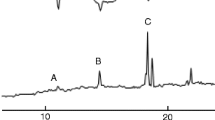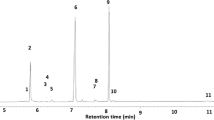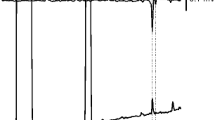Abstract
The airborne sex pheromone components (Z,E)-9,12-tetradeca-dien-1-yl acetate and (Z)-9-tetradecen-1-y1 acetate from single calling females ofEphestia cautella (Walker) were trapped within glass capillary tubes and were measured by gas chromatography-mass spectrometry. Broad and similar distributions of relative quantities were found for a laboratory strain and three Australian field strains, and means differed strongly from those reported previously for this species. The overall mean proportion of the two components found for Australian females was 88∶12. The composition in individuals ranged from 63∶27 to 97∶3. The proportions for individuals appeared to vary slightly in a random fashion from day to day, and proportions for first-generation progeny were influenced by the maternal blend.
Similar content being viewed by others
References
Baker, T.C. Gaston, L.K., Pope, M.M., Kuenen, L.P.S., andVetter, R.S. 1981. A high-efficiency collection device for quantifying sex pheromone volatilized from female glands and synthetic sources.J. Chem. Ecol. 7:961–968.
Barrer, P.M. 1976. The influence of delayed mating on the reproduction ofEphestia cautella (Walker) (Lepidoptera: Phycitidae).J. Stored Prod. Res. 12:165–169.
Barrer, P.M., andHill, R.J. 1977. Some aspects of the courtship behaviour ofEphestia cautella (Walker) (Lepidoptera: Phycitidae).J. Aust. Entomol. Soc. 17:71–82.
Barrer, P.M.,Shani, A.,Lacey, M.J., andWhittle, C.P. 1984. Variation between individualEphestia cautella females in the composition of the sex pheromone blend. Abstracts XVII International Congress of Entomology, Hamburg, 1984, p. 468.
Brady, U.E. 1973. Isolation, identification and stimulatory activity of a second component of the sex pheromone system (complex) of the female almond mothEphestia cautella (Walker).Life Sci. 13:227–235.
Brady, U.E., andDaley, R.C. 1972. Identification of a sex pheromone from the female raisin moth,Cadra figulilella.Ann. Entomol. Soc. Am. 65:1356–1358.
Brady, U.E., andNordlund, D.A. 1971.cis-9,trans-12-Tetradecadien-1-yl acetate in the female tobacco mothEphestia elutella (Hübner) and evidence for an additional component of the sex pheromone.Life Sci. 10:797–801.
Brady, U.E., Nordlund, D.A., andDaley, R.C. 1971a. The sex stimulant of the Mediterranean flour mothAnagasta kuehniella.J. Ga. Entomol. Soc. 6:215–217.
Brady, U.E., Tumlinson, J.H., Brownlee, R.G., andSilverstein, R.M. 1971b. Sex stimulant and attractant in the Indian meal moth and in the almond moth.Science 171:802–804.
Campion, D.G., Hunter-Jones, P., McVeigh, L.J., Hall, D.R., Lester, R., andNesbitt, B.F. 1980. Modification of the attractiveness of the primary pheromone component of the Egyptian cotton leafworm,Spodoptera littoralis (Boisduval) (Lepidoptera: Noctuidae), by secondary pheromone components and related chemicals.Bull. Entomol. Res. 70:417–434.
Cardé, R.T., andBaker, T.C. 1984. Sexual communication with pheromones, pp. 355–383,in W.J. Bell and R.T. Cardé (eds.). Chemical Ecology of Insects. Chapman and Hall, London.
Cardé, R.T., Cardé, A.M., Hill, A.S., andRoelofs, W. 1977. Sex pheromone specificity as a reproductive isolating mechanism among the sibling speciesArchips argyrospilus andA. mortuanus and other sympatric tortricine moths (Lepidoptera: Tortricidae).J. Chem. Ecol. 3:71–84.
Cardé, R.T., Roelofs, W.L., Harrison, R.G., Vawter, A.T., Brussard, P.F., Mutuura, A., andMonroe, E. 1978. European corn borer: Pheromone polymorphism or sibling species.Science 199:555–556.
Coffelt, J.A., Sower, L.L., andVick, K.W. 1978. Quantitative analysis of identified compounds in pheromone gland rinses ofPlodia interpunctella andEphestia cautella at different times of the day.Environ. Entomol. 7:502–505.
Collins, R.D., andCardé, R.T. 1985. Variability in and heritability of aspects of pheromone production in the pink bollworm moth,Pectinophora gossypiella (Lepidoptera: Gelechiidae).Ann. Entomol. Soc. Am. 78:229–234.
Ganyard, M.C., andBrady, U.E. 1971. Inhibition of attraction and cross attraction by interspecific sex pheromone communication in Lepidoptera.Nature 234:415–416.
Greenfield, M.D. 1981. Moth sex pheroraones: an evolutionary perspective.Fla. Entomol. 64:4–17.
Haynes, K.F., Gaston, L.K., Pope, M.M., andBaker, T.C. 1984. Potential for evolution of resistance to pheromones: Interindividual and interpopulational variation in chemical communication system of pink bollworm moth.J. Chem. Ecol. 10:1551–1565.
Klun, J.A., andCooperators 1975. Insect sex pheromones: Intraspecific pheromonal variability ofOstrinia nubilalis in North America and Europe.Environ. Entomol. 4:891–894.
Klun, J.A., Chapman, D.L., Mattes, K.C., Wojtkowski, P.W., Beroza, M., andSonnet, P.E. 1973. Insect sex pheromones: Minor amount of opposite geometrical isomer critical to attraction.Science 181:661–663.
Kuwahara, Y., andCasida, J.E. 1973. Quantitative analysis of the sex pheromone of several phycitid moths by electron-capture gas chromatography.Agric. Biol. Chem. 37:681–684.
Kuwahara, Y., Hara, H. Ishii, S., andFukami, H. 1971a. The sex pheromone of the Mediterranean flour moth.Agric. Biol. Chem. 35:447–448.
Kuwahara, Y., Kitamura, C., Takahashi, S., Hara, H., Ishii, S., andFukami, H. 1971b. Sex pheromones of the almond moth and the Indian meal moth:cis-9,trans-12-Tetradecadienyl acetate.Science 171:801–802.
Miller, J.R., andRoelofs, W.L. 1980. Individual variation in sex pheromone component ratios in two populations of the redbanded leafroller moth,Argyrotaenia velutinana.Environ. Entomol. 9:359–363.
Pope, M.M., Gaston, L.K., andBaker, T.C. 1982. Composition, quantification, and periodicity of sex pheromone gland volatiles from individualHeliothis virescens females.J. Chem. Ecol. 8:1043–1055.
Read, J.S., andBeevor, P.S. 1976. Analytical studies of the sex pheromone complex ofEphestia cautella (Walker) (Lepidoptera: Phycitidae).J. Stored Prod. Res. 12:55–57.
Read, J.S., andHaines, C.P. 1976. The functions of the female sex pheromones ofEphestia cautella (Walker) (Lepidoptera: Phycitidae)J. Stored Prod. Res. 12:49–53.
Read, J.S., andHaines, C.P. 1979. Secondary pheromone components and synergism in stored-products phycitinae.J. Chem. Ecol. 5:251–257.
Roelofs, W., Hill, A., Cardé, R., Tette, J., Marsden, H., andVakenti, J. 1974. Sex pheromone of the fruit tree leafroller moth,Archips argyrospilus.Environ. Entomol. 3:747–751.
Shani, A., andLacey, M.J. 1984. Convenient method applicable to single insects for collection and measurement of blend ratios of airborne pheromones from artificial sources.J. Chem. Ecol. 10:1677–1692.
Shani, A., Lacey, M.J., Barrer, P.M., andWhittle, C.P. 1985. Collection and measurement of airborne sex pheromone from single live females of the almond moth (Ephestia cautella): Population profile. (Abstracts of papers 4th Meeting on Pheromone Research in Israel, Tel Aviv, 1985.)Phytoparasitica 13:145.
Silk, P.J., Kuenen, L.P.S., Tan, S.H., Roelofs, W.L., Sanders, C.J., andAlford, A.R. 1985. Identification of sex pheromone components of jack pine budwormChoristoneura pinus pinus Freeman.J. Chem. Ecol. 11:159–167.
Sower, L.L., Coffelt, J.A., andVick, K.W. 1973. Sex pheromones: A simple method of obtaining relatively pure material from females of five species of moths.J. Econ. Entomol. 66:1220–1222.
Sower, L.L., Vick, K.W., andTumlinson, J.H. 1974. (Z,E)-9,12-Tetradecadien-1-ol: A chemical released by femalePlodia interpunctella that inhibits the sex pheromone response of maleCadra cautella.Environ. Entomol. 3:120–122.
Zar, J.H. 1974. Biostatistical Analysis. Prentice-Hall, Englewood Cliffs, New Jersey.
Author information
Authors and Affiliations
Additional information
Author order in this paper is alphabetical
Rights and permissions
About this article
Cite this article
Barrer, P.M., Lacey, M.J. & Shani, A. Variation in relative quantities of airborne sex pheromone components from individual femaleEphestia cautella (Lepidoptera: Pyralidae). J Chem Ecol 13, 639–653 (1987). https://doi.org/10.1007/BF01880106
Received:
Accepted:
Issue Date:
DOI: https://doi.org/10.1007/BF01880106




